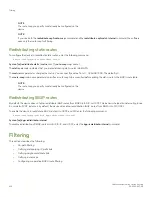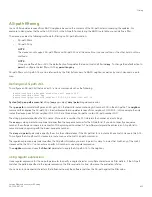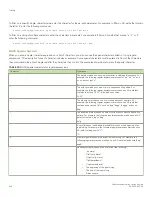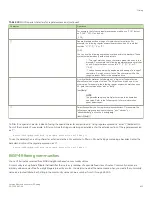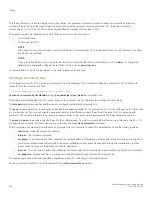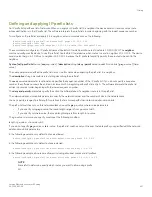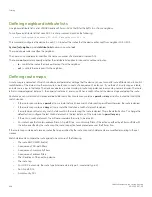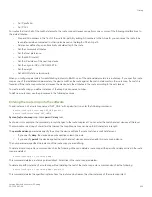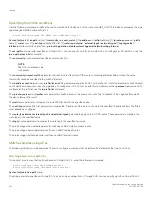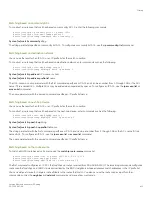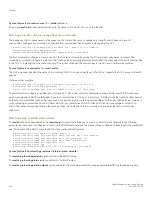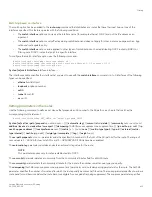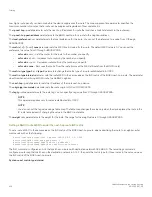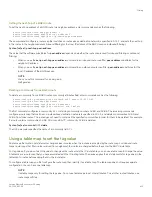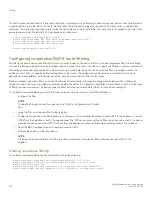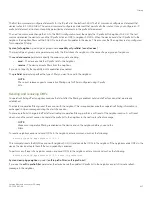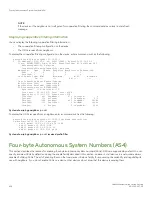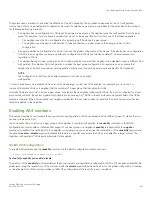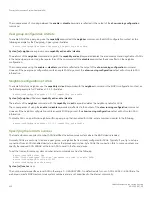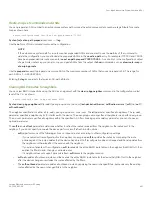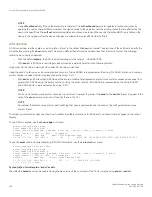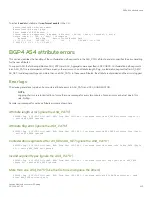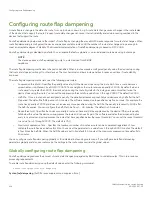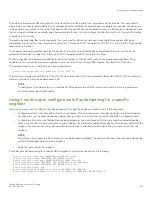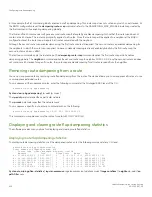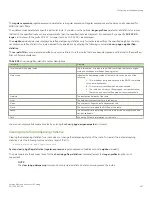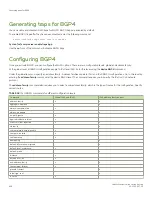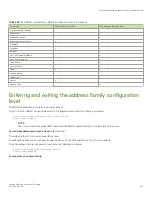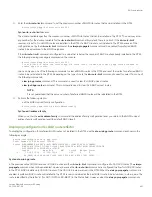
To create a route map and identify it as a table map, enter commands such as following. These commands create a route map that uses
an address filter. For routes that match the IP prefix list filter, the route map changes the tag value to 100 and is then considered as a
table map. This route map is applied only to routes the device places in the IP route table. The route map is not applied to all routes. This
example assumes that IP prefix list p11 has already been configured.
device(config)# route-map TAG_IP permit 1
device(config-routemap TAG_IP)# match ip address prefix-list p11
device(config-routemap TAG_IP)# set tag 100
device(config-routemap TAG_IP)# router bgp
device(config-bgp)# table-map TAG_IP
Configuring cooperative BGP4 route filtering
By default, the device performs all filtering of incoming routes locally, on the device itself. You can use cooperative BGP4 route filtering
to cause the filtering to be performed by a neighbor before it sends the routes to the device. Cooperative filtering conserves resources by
eliminating unnecessary route updates and filter processing. For example, the device can send a deny filter to a neighbor, which the
neighbor uses to filter out updates before sending them to the device. The neighbor saves the resources it would otherwise use to
generate the route updates, and the device saves the resources it would use to filter out the routes.
When you enable cooperative filtering, the device advertises this capability in its Open message to the neighbor when initiating the
neighbor session. The Open message also indicates whether the device is configured to send filters, receive filters, or both, and the types
of filters it can send or receive. The device sends the filters as Outbound Route Filters (ORFs) in route refresh messages.
To configure cooperative filtering, perform the following tasks on the device and on the BGP4 neighbor:
•
Configure the filter.
NOTE
Cooperative filtering is currently supported only for filters configured using IP prefix
lists.
•
Apply the filter as an inbound filter to the neighbor.
•
Enable the cooperative route filtering feature on the device. You can enable the device to send ORFs to the neighbor, to receive
ORFs from the neighbor, or both. The neighbor uses the ORFs you send as outbound filters when it sends routes to the device.
Likewise, the device uses the ORFs it receives from the neighbor as outbound filters when sending routes to the neighbor.
•
Reset the BGP4 neighbor session to send and receive ORFs.
•
Perform these steps on the other device.
NOTE
If the device has inbound filters, the filters are still processed even if equivalent filters have been sent as ORFs to the
neighbor.
Enabling cooperative filtering
To configure cooperative filtering, enter commands such as the following.
device(config)# ip prefix-list Routesfrom10234 deny 10.20.0.0/24
device(config)# ip prefix-list Routesfrom10234 permit 0.0.0.0/0 le 32
device(config)# router bgp
device(config-bgp-router)# neighbor 10.2.3.4 prefix-list Routesfrom1234 in
device(config-bgp-router)# neighbor 10.2.3.4 capability orf prefixlist send
Filtering
FastIron Ethernet Switch Layer 3 Routing
416
53-1003627-04
Summary of Contents for FastIron SX 1600
Page 2: ...FastIron Ethernet Switch Layer 3 Routing 2 53 1003627 04 ...
Page 16: ...FastIron Ethernet Switch Layer 3 Routing 16 53 1003627 04 ...
Page 20: ...FastIron Ethernet Switch Layer 3 Routing 20 53 1003627 04 ...
Page 142: ...FastIron Ethernet Switch Layer 3 Routing 142 53 1003627 04 ...
Page 150: ...FastIron Ethernet Switch Layer 3 Routing 150 53 1003627 04 ...
Page 200: ...FastIron Ethernet Switch Layer 3 Routing 200 53 1003627 04 ...
Page 214: ...FastIron Ethernet Switch Layer 3 Routing 214 53 1003627 04 ...
Page 350: ...FastIron Ethernet Switch Layer 3 Routing 350 53 1003627 04 ...
Page 476: ...FastIron Ethernet Switch Layer 3 Routing 476 53 1003627 04 ...
Page 588: ...FastIron Ethernet Switch Layer 3 Routing 588 53 1003627 04 ...

